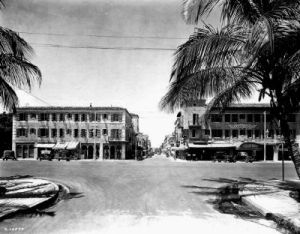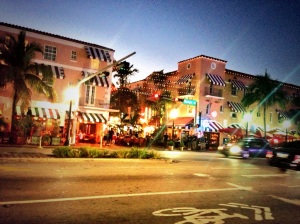Espanola Way is the City’s most historic commercial street. It was built in 1925 to be like “A Latin Greenwich Village of …fiestas and song, mantillas and lace.” Its Spanish Mediterranean architecture is modeled after the villages in San Sebastian on the Coast of Spain, the Biarritz in Cannes and the Mentone in France, “places where artists and lovers of the artistic might congregate amid congenial surroundings.” (As quoted from its original owner and architect N.B.T Roney and Robert A. Taylor).
Originally the street was lined with shops selling fashionable merchandise, “aimed to set the style for Paris rather than imitate it.” One could find rare books, antiques, fine clothes and jewelry. Restaurants and teahouses served international cuisine including English, French, Chinese and Spanish of course. Thereafter many artists and musicians took up residence and Espanola Way took on the bohemian atmosphere that Roney imagined. In 1925 the Miami News described the Spanish Village as, “destined to become a famous place among artists and intellectuals of the nations.” The roaring 20’s and 30’s brought with it street parties, gamblers and bootleggers. The Port of Missing Men was a popular nightclub for infamous gangsters like Al Capone.
During World War II Miami Beach served as a training site for U.S. armed forces. 25% of the US armed forces trained in South Florida. The hotels of Espanola Way became home for many soldiers preparing to sail over seas. After the war The Spanish Village took on a new life. Music, notably Mambo and Rumba, pulsed thorough the clubs and hotels and dance studios opened along the street as well as throughout all the hotels in Miami Beach. Bandleader Desi Arnez gave the street a distinctly Latin flavor when he started the rumba dance craze. Espanola Way became known as, “The Rumba Capital of the World.”
Once again the street is filled with its original bohemian atmosphere. People of all different walks of life have chosen the area for their business or residence. Many artists of different mediums have working studios in the Espanola Way Arts Center.
On the weekend and during all evenings, the street becomes pedestrian-only, allowing for carefree strolls.
A variety of quaint restaurants and cafes of international flavors continue to line Espanola Way, from Brazilian to Italian to Japanese to Peruvian, French or Spanish, giving visitors and locals many places in which to enjoy an array of dining experiences. Whether your mood is for fine dining, to eat Spanish tapas while watching a Flamenco show, relish authentic Mexican, or you prefer to sit and people watch at a quiet outdoor French café and creperie, or simply have a gelato, you will have the opportunity to savor tastes from all over the world.
Moreover, there is a variety of clothing and jewelry boutiques, and art in the artist lofts and residences. Meanwhile, Miami Beach’s oldest yoga studio offers classes day and night. And, you can even have your hair styled at one of Miami’s hippest salons for men and women. Needless to say, Espanola Way offers you ample ways to indulge your personal interests and style.


